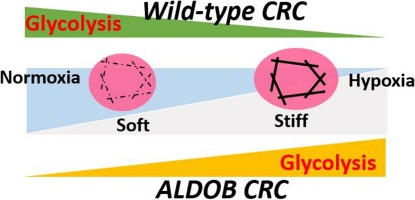当前位置:
X-MOL 学术
›
Colloids Surf. B Biointerfaces
›
论文详情
Our official English website, www.x-mol.net, welcomes your
feedback! (Note: you will need to create a separate account there.)
Aldolase triggers metabolic reprogramming in colorectal cancer in hypoxia and stiff desmoplastic microenvironments.
Colloids and Surfaces B: Biointerfaces ( IF 5.4 ) Pub Date : 2020-03-18 , DOI: 10.1016/j.colsurfb.2020.110969 Hou-Chun Huang,Wey-Ran Lin,Siew-Na Lim,Chau-Ting Yeh,Tzung-Hai Yen,Malcolm R Alison,Chi-Shuo Chen
Colloids and Surfaces B: Biointerfaces ( IF 5.4 ) Pub Date : 2020-03-18 , DOI: 10.1016/j.colsurfb.2020.110969 Hou-Chun Huang,Wey-Ran Lin,Siew-Na Lim,Chau-Ting Yeh,Tzung-Hai Yen,Malcolm R Alison,Chi-Shuo Chen

|
Colorectal cancer (CRC) progression is highly associated with desmoplasia. Aerobic glycolysis is another distinct feature that appears during the CRC phase of the adenoma-carcinoma sequence. However, the interconnections between the desmoplastic microenvironment and metabolic reprogramming remain largely unexplored. In our in vitro model, we investigated the compounding influences of hypoxia and substrate stiffness, two critical physical features of desmoplasia, on the CRC metabolic shift by using engineered polyacrylamide gels. Unexpectedly, we found that compared to cells on a soft gel (approximately 1.5 kPa, normal tissue), cells on a stiff gel (approximately 8.7 kPa, desmoplastic tissue) exhibited reduced glucose uptake and glycolysis under both normoxia and hypoxia. In addition, the increasing substrate stiffness activated focal adhesion kinase (FAK)/phosphoinositide 3-kinase signaling, but not the mitochondrial respiratory inhibitor HIF-1α. However, the presence of aldolase B (ALDOB) reversed the CRC metabolic response to mechanosignaling; enhanced glucose uptake (approximately 1.5-fold) and aerobic glycolysis (approximately 2- to 3--fold) with significantly decreased mitochondrial oxidative phosphorylation. ALDOB also changed the response of CRC traction force, which is related to tumor metastasis, under hypoxia/normoxia. In summary, our data suggest a counter influence of hypoxia and substrate stiffness on glucose uptake, and ALDOB upregulation can reverse this, which drives hypoxia and stiff substrate to enhance the CRC aerobic glycolysis synergistically. The results not only highlight the potential impacts on metabolic reprogramming led by physical alterations in the microenvironment, but also extend our understanding of the essential role of ALDOB in CRC progression from a biophysical perspective.
中文翻译:

在缺氧和僵硬的增生微环境中,醛缩酶触发大肠癌的代谢重编程。
结直肠癌(CRC)的进展与增生高度相关。有氧糖酵解是在腺瘤-癌序列的CRC阶段出现的另一个独特特征。但是,增塑微环境与代谢重编程之间的相互联系仍在很大程度上未被探索。在我们的体外模型中,我们使用工程聚丙烯酰胺凝胶研究了缺氧和基质僵硬,增生的两个关键物理特征对CRC代谢转变的复合影响。出乎意料的是,我们发现与软凝胶(大约1.5 kPa,正常组织)上的细胞相比,硬凝胶(大约8.7 kPa,增生组织)上的细胞在常氧和低氧下均表现出降低的葡萄糖摄取和糖酵解。此外,底物刚度的增加激活了粘着斑激酶(FAK)/磷酸肌醇3激酶信号传导,但不激活线粒体呼吸抑制剂HIF-1α。然而,醛缩酶B(ALDOB)的存在逆转了CRC对机械信号转导的代谢反应。增强的葡萄糖吸收(约1.5倍)和有氧糖酵解(约2到3倍),线粒体氧化磷酸化明显降低。在缺氧/常氧下,ALDOB还改变了与肿瘤转移相关的CRC牵引力的反应。总而言之,我们的数据表明缺氧和底物硬度对葡萄糖摄取有反作用,而ALDOB上调可以逆转这种情况,从而驱动缺氧和底物刚性以协同增强CRC有氧糖酵解。
更新日期:2020-03-19
中文翻译:

在缺氧和僵硬的增生微环境中,醛缩酶触发大肠癌的代谢重编程。
结直肠癌(CRC)的进展与增生高度相关。有氧糖酵解是在腺瘤-癌序列的CRC阶段出现的另一个独特特征。但是,增塑微环境与代谢重编程之间的相互联系仍在很大程度上未被探索。在我们的体外模型中,我们使用工程聚丙烯酰胺凝胶研究了缺氧和基质僵硬,增生的两个关键物理特征对CRC代谢转变的复合影响。出乎意料的是,我们发现与软凝胶(大约1.5 kPa,正常组织)上的细胞相比,硬凝胶(大约8.7 kPa,增生组织)上的细胞在常氧和低氧下均表现出降低的葡萄糖摄取和糖酵解。此外,底物刚度的增加激活了粘着斑激酶(FAK)/磷酸肌醇3激酶信号传导,但不激活线粒体呼吸抑制剂HIF-1α。然而,醛缩酶B(ALDOB)的存在逆转了CRC对机械信号转导的代谢反应。增强的葡萄糖吸收(约1.5倍)和有氧糖酵解(约2到3倍),线粒体氧化磷酸化明显降低。在缺氧/常氧下,ALDOB还改变了与肿瘤转移相关的CRC牵引力的反应。总而言之,我们的数据表明缺氧和底物硬度对葡萄糖摄取有反作用,而ALDOB上调可以逆转这种情况,从而驱动缺氧和底物刚性以协同增强CRC有氧糖酵解。










































 京公网安备 11010802027423号
京公网安备 11010802027423号